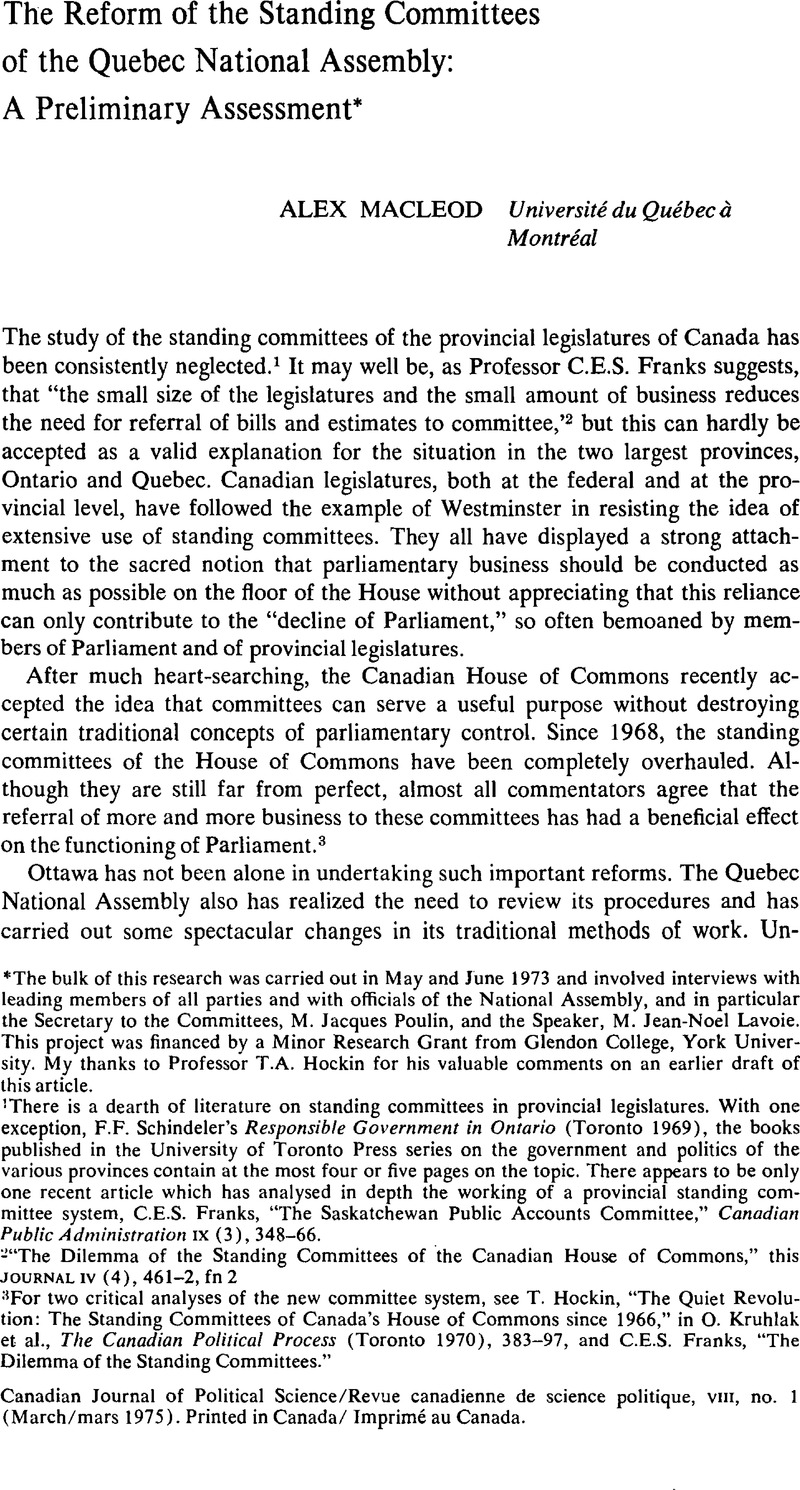Published online by Cambridge University Press: 10 November 2009

1 There is a dearth of literature on standing committees in provincial legislatures. With one exception, Schindeler's, F.F.Responsible Government in Ontario (Toronto 1969)Google Scholar, the books published in the University of Toronto Press series on the government and politics of the various provinces contain at the most four or five pages on the topic. There appears to be only one recent article which has analysed in depth the working of a provincial standing committee system, C.E.S. Franks, “The Saskatchewan Public Accounts Committee,” Canadian Public Administration ix (3), 348–66.
2 The Dilemma of the Standing Committees of the Canadian House of Commons,” this Journal iv (4), 461–2, fn 2
3 For two critical analyses of the new committee system, see Hockin, T., “The Quiet Revolution: The Standing Committees of Canada's House of Commons since 1966,” in Kruhlak, O. et al., The Canadian Political Process (Toronto 1970), 383–97,Google Scholar and C.E.S. Franks, “The Dilemma of the Standing Committees.”
4 A more detailed account of the evolution of Quebec's standing committees between 1964 and 1971 is to be found in Benezra, G., Les systèmes canadien et québécois des commissions parlementaires, unpublished doctoral dissertation, University of Ottawa, 1972, 124–8 and 133–7.Google Scholar
5 Speech given before the Interclub de l'Est de Montréal, 19 February 1970
6 Party standings in the National Assembly after the elections of April 1970 were: Liberals 72, Union Nationale 17, Ralliement des Créditistes 12, Parti Québécois 7.
7 Since March 1973, the Assembly has had standing committees on the following subjects: the National Assembly; the Presidency of the Council, the Constitution and Intergovernmental Affairs; Justice; Finance, Public Accounts and Revenue; Natural Resources and Lands and Forests; Agriculture and Colonization; Labour, Manpower and Immigration; Social Affairs; Municipal Affairs; Industry and Commerce, and Tourism, Fish and Game; Transport, Public Works and Supply; Education, Cultural Affairs and Communications; Financial Institutions, Companies and Cooperatives; the Civil Service; Financial Commitments; and Professional Corporations. There is also a special Committee on the Freedom of the Press.
8 The Standing Committee on the National Assembly has 19 members, that on Professional Corporations, 23.
9 See Benezra, Les systèmes canadien et québécois.
10 s.o. 139 states that the Speaker submits a list of at least seven names to the Committee on the National Assembly, but this merely represents ratification of a decision taken elsewhere. Since March 1973, one of the two deputy speakers may also preside over a committee.
11 For the drafting of reports of the standing committees of the Canadian House of Commons, see C.E.S. Franks, “The Dilemma of the Standing Committees,” 469–70.
12 This rule follows indirectly from s.o. 151. In theory this practice marks a retrogressive step compared to the procedure established by the former Standing Orders, s.o. 465 of the old rules stated that standing committees “may consider all matters under their jurisdiction, although no such matters have been referred to them by the House.” There is no evidence that committees ever showed such independence.
13 s.o. 153 declares that: “When a select committee has required any person to appear before it to be heard or file documents and such a person refuses to comply, the committee shall report such a refusal to the President [i.e. the Speaker] who shall take the necessary steps to enforce the order of the committee.”
14 Much of the inquiry into electoral reform took place in the Committee on the National Assembly without the presence of a minister. The government was represented by Denis Hardy, who subsequently became parliamentary secretary to the minister of cultural affairs, but the committee successfully entrusted the preparation of its work schedule to a steering committee containing only one representative from each of the four parties.
15 On the question of the development, and limitations, of specialized standing committees at Westminster, see Crick, B., The Reform of Parliament, (London2nd edition, 1968), 89–98, and 212–17.Google Scholar
16 The Fifth Republic has reduced the number of committees from 19 to 6 and rendered them almost totally ineffective.
17 A notable exception to this general statement was the attempt made by Maurice Duplessis, then leader of the opposition, to use the Public Accounts Committee to expose the failings of the Taschereau government, which, as a result, was brought down in 1936.
18 See the Journal des Débats, 19 November 1971, 4337.
19 After second reading, a bill, except a bill of supply, must be sent to the appropriate select committee on a motion without notice by the government House Leader that cannot be debated or amended. However, on a motion without notice by the government House Leader, the Assembly may decide to refer it to the Committee of the Whole.”
20 Of the 79 bills that were passed in the third session of the legislature (1972–3), 27 were actually referred to a standing committee after second reading. However, the vast majority of the remaining 52 bills were of a non-controversial nature and often went through all readings in consecutive sittings.
21 Journal des Débats, Commissions parlementaires, 5 September 1972, b-5175
22 Journal des Débats, Commissions parlementaires, 9 March 1971, b-543
23 Article 8 of Bill 19, which ordered striking civil servants back to work, reads as follows: “The Parliamentary Committee on the Civil Service shall meet on Tuesday the 25th of April 1972 to receive from the representatives of associations of employees and those of employers explanations respecting the negotiations of collective agreements between the associations of employees and the employers.”
24 s.o. 126 strictly limits the third reading. It states: “The debate on the motion for third reading of the bill shall be limited to its content. This motion cannot be amended. Each recognized party shall be entitled to only one speech.” The opposition has made little attempt to exercise its right to debate the third reading.
25 See Crick, The Reform of Parliament, 79–83.